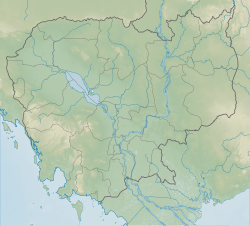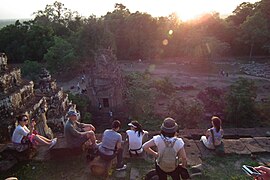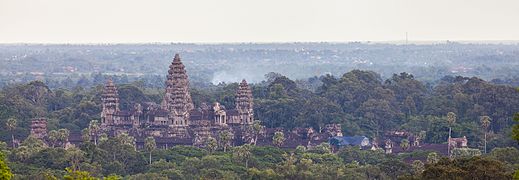Phnom Bakheng
| Phnom Bakheng | |
|---|---|
ភ្នំបាខែង | |
Bakheng style) | |
| Creator | Yasovarman I |
| Completed | 889–910 AD |
| Phnom Bakheng | |
|---|---|
 View from the hill | |
| Highest point | |
| Elevation | 79 m (259 ft)[1] |
| Coordinates | 13°25′25″N 103°51′22″E / 13.42361°N 103.85611°E |
| Geography | |
| Location | Siem Reap Province, Cambodia |
| Climbing | |
| Easiest route | Hiking |
Phnom Bakheng (
History Phnom Bakheng, built more than two centuries before Angkor Wat, was once the main temple in the Angkor region. It was the central architectural feature of a new capital called Yasodharapura, established by Yasovarman when he moved the court from the old capital, Hariharalaya, in the southeast Roluos area.[4]
An inscription dated 1052 AD and found at the
Phnom Bakheng is one of 3 hilltop temples in the Angkor region that are attributed to Yasovarman's reign. The other two are
Workers built a protective outer moat around the mountain and temple. There were avenues extending in the north, south, east, and west directions from the mountain. A raised pathway, first going northwest to southeast from the old capital to the new capital's outer moat, and then turning to go east to west, connected directly to the east entrance of the temple.[8]
Later in its history, Phnom Bakheng was converted into a Buddhist temple. A monumental Sitting Buddha, now lost, was created on its upper tier. Across its west side, a Reclining Buddha of similar scale was crafted in stone. The outlines of this figure are still visible.
Symbolism
Phnom Bakheng is a symbolic representation of
Jean Filliozat of the Ecole Francaise, a leading western authority on Indian cosmology and astronomy, interpreted the symbolism of the temple. The temple sits on a rectangular base and rises in five levels and is crowned by five main towers. One hundred four smaller towers are distributed over the lower four levels, placed so symmetrically that only 33 can be seen from the center of any side. Thirty-three is the number of gods who dwelt on Mount Meru. Phnom Bakheng's total number of towers is also significant. The center one represents the axis of the world and the 108 smaller ones represent the four lunar phases, each with 27 days. The seven levels of the monument represent the seven heavens and each terrace contains 12 towers which represent the 12-year cycle of Jupiter. According to University of Chicago scholar Paul Wheatley, it is "an astronomical calendar in stone."[11]
Following Angkor's rediscovery by the outside world in the mid-19th century, decades passed before archeologists grasped Phnom Bakheng's historical significance. For many years, scholars' consensus view was that the
Phnom Bakheng in popular media
The view of the Angkor Wat from the top of Phnom Bakheng is featured in the movie Tomb Raider (when Lara Croft looks through the binoculars upon arriving in Cambodia).
Gallery
-
Tonlé Sap seen from Phnom Bakheng
-
Phnom Bakheng is a viewpoint of the setting sun
-
Phnom Bakheng
-
Angkor Wat seen from Phnom Bakheng at sunset
-
General view
-
Upper terrace
-
Stone tower and Angkor Wat far afield
-
Bas-reliefin Phnom Bakheng
See also
- Angkor
- Architecture of Cambodia
- List of archaeoastronomical sites by country
Notes
- ^ Google Earth
- ^ Coedès (1968), p. 103.
- ^ Smith, Justine (25 February 2007). "Tourist invasion threatens to ruin glories of Angkor Wat". The Observer.
- ^ Coedès (1968), pp. 112–113.
- ^ Sak-Humphry (2005), p. 38.
- ^ a b Coedès (1968), p. 112.
- ^ Coedès (1968), p. 113.
- ^ Higham (2001), p. 64.
- ^ Higham (2014), pp. 355, 358–360.
- ^ Rooney (2002), p. 236.
- ^ Time Life Lost Civilizations series: Southeast Asia: A Past Regained (1995) p.93-4
References
- ISBN 978-0-8248-0368-1.
- Goloubev, Victor. Le Phnom Bakheng et la ville de Yasovarman. Bulletin de l'EFEO (Paris), 33 (1933): 319–344.
- Goloubev, Victor. Nouvelles récherches autour de Phnom Bakhen. Bulletin de l'EFEO (Paris), 34 (1934): 576–600.
- Higham, Charles (2014). Early Mainland Southeast Asia. Bangkok: River Books Co., Ltd. ISBN 9786167339443.
- Higham, Charles (2001). The Civilization of Angkor. Bangkok: University of California Press.
- Rooney, Dawn (2002). Angkor (Fourth ed.). Airphoto International Ltd.
- Sak-Humphry, Chhany (2005). The Sdok Kak Thom Inscription. The Buddhist Institute.










